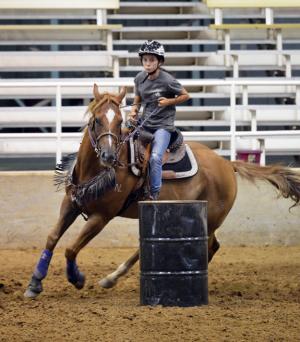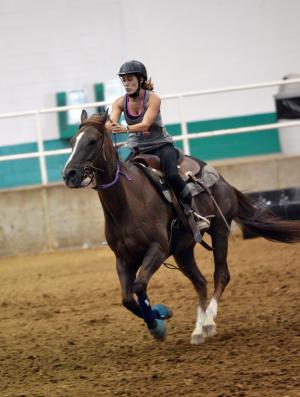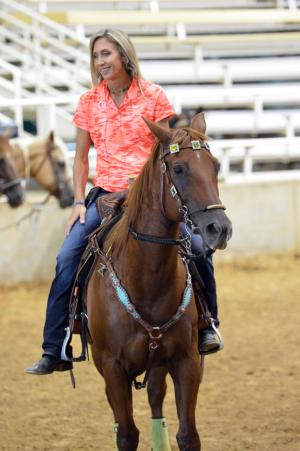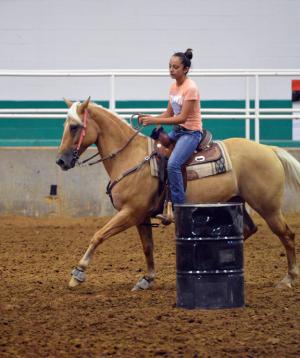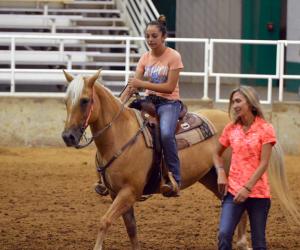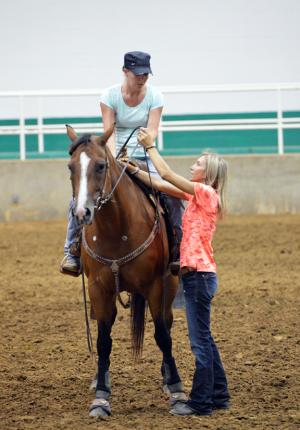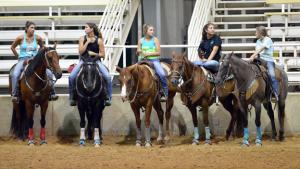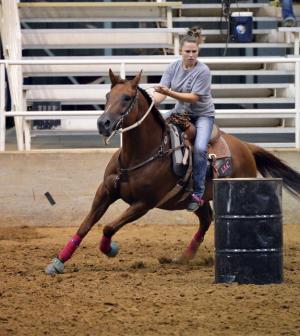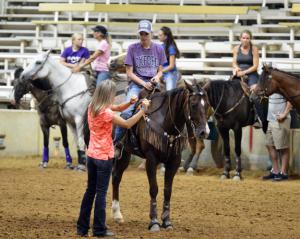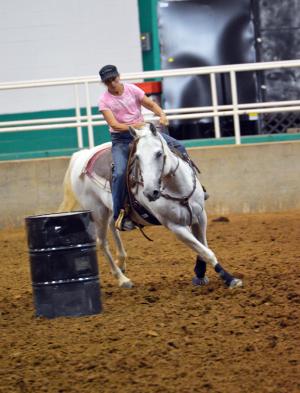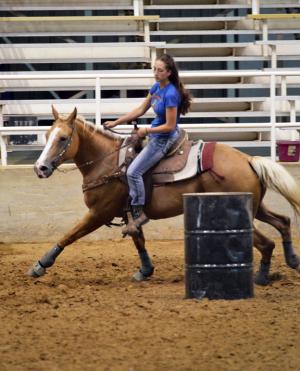Article & photos by Nancy Brannon
Charmayne James brought her barrel racing skills to the ShowPlace Arena in Memphis, Tenn., July 6-9, 2017 for an intense 4-day clinic, with 30 riders participating. The clinic ran from 8:00 a.m. to around 5 p.m. daily, and Charmayne gave a demonstration at 5:30 p.m. on Thursday, first day of the clinic.
As James worked individually with the riders, she often had praise for them, “good job!” or “I like the way you’re working on your position and hands.” She called each rider by their name, and offered her critique of their ride and suggestions for improvement. There were several points that she emphasized with all of them, starting with the logistics of turning around the barrels.
First, she explained the axis points around the barrels, which are about 4 feet equidistant from the barrel all the way around. “The first is at the entry to the turn; the third is between the barrel and the fence (or wall); the fifth is opposite the first; and the seventh is the opposite of point 3,” James explained. “Stay the same distance [from the barrel] at all points and the horse stays round.”
She continued, “Ride the front feet and the back feet over each of the axis points; all four feet have to hit each one. Typically, if you ride the back feet over each of the points, the front feet will also go over them. The horse gets his power from the hind end, so you don’t want to ride just the front feet over the axis points with the horse’s hind end trailing to the outside. If the horse is swinging his hip to the outside, he’s not getting power from his hind end. If you think about riding the back end, and where you point the head and shoulders, you’ll do a much better job of guiding the horse where he needs to go.”
Along with the axis points, she had riders keep their horses straight down the center line for a few strides before making a smooth arc toward the axis points of the first barrel. “Come into the arena heading for the third barrel for a little bit. The first few steps should be straight; then start a gradual arc about eight feet before the first barrel. Don’t turn the first barrel starting at an angle,” she explained. “Set up your horse early going to the first barrel, heading for the first axis point.”
That set up should include going to the first barrel on the correct lead. Many riders headed to the first barrel on the opposite lead and the horses had to switch leads as they started around the barrel. This slight adjustment can cost seconds on the clock.
Secondshe emphasized soft hands. “Don’t pull the horse’s head around,” she said. “Smooth hands. And keep your body soft. Let the horse work under you. Everywhere you go you see riders over bending the horse’s head to the inside too much and the rider looking down at the barrel. If I did what everybody else is doing, I’d have been bankrupt long ago!”
James emphasized not over bending the head and neck, or allowing the horse’s hind end to “fishtail” off the circle around the axis poings. Straighten the horse’s nose and ride the horse’s feet through the axis points around the barrel. Have the horse's nose bent slightly to the inside, and do not cross the rein over the neck with your inside hand. If you take the rein across the neck, you start pulling on the inside rein too much. That makes the horse turn more into the barrel. Not only should the inside hand never cross the neck, but it should never pull straight down or straight back. James emphasized not over bending the head and neck, or allowing the horse’s hind end to “fishtail” off the circle around the axis points.
Third, she emphasized collection and rating the horse, using slow work first to get the precision needed around the barrels. She had riders lope their horses around a barrel several times, practicing getting the horse consistent and keeping the horse’s head straight. When doing slow work, support with the outside rein and keep some contact. The outside rein supports and balances the horse’s outside shoulder and allows the rider to keep the back end driving forward at the same time.
Riders must be able to collect and rate their horses. If the horse’s head goes up and/or he opens his mouth when the rider cues with the reins, the horse is resisting the bit cues and is very difficult to rate. Riders must be able to collect the horse for the turns. If the horse cannot be collected, the horse will not be able to utilize power from the hind end and negotiate the turns correctly.
James said that a lot of barrel racers are taught to use the inside leg and rein only, but that leads to the horse tracking his hind end outside of his front feet and takes away the horse’s speed and power. She says, “Learn to feel where the inside hock of your horse is. Open and close your eyes while riding to learn to feel where the horse is placing that inside hock. Riding for proper placement of the inside hock is the key to everything!”
James uses her inside and outside legs to move the horse laterally. The horse needs to move off cues from the rider’s legs. If you want to move the horse’s hip closer to the barrel, put a little outside leg on the horse.
“The fastest turn results from driving the horse’s hind end forward all the way around the axis points. If your elbows get stiff and you lean forward when you’re close to the barrel and throw the reins up on the horse’s neck, this tends to throw the horse onto his forehand, which is the setup for a slower turn involving more steps around the barrel,” she explained.
Some common problems James sees among her students:
(1) Riders lift their shoulder and use only their inside leg to make the turn. They turn the horse’s nose too early, thus the front feet are too close to the barrel and the hip goes out off the turn. “This doesn’t work!” she explained.
(2) Riders not paying attention to the amount of pressure in their hands and where they are aiming the horse’s head. “Keep the head straight in front of the body. You want the horse’s nose down, driving into the bit.”
(3) When going into the barrels, the rider should move his/her eye up ahead because the barrel is NOT the focal point. “If you focus on the barrel, you are going to be three feet short of where you need to be at every barrel. Your depth perception is nine feet short over the total pattern if you’re looking at the barrels. And if your depth perception is that short, it affects the clock,” James explained.
(4) The rider needs to hold good posture in the saddle, with their legs underneath them, and maintaining good contact with the legs.
(5) When a rider learns to recognize and feel the correct way to guide, the horse can begin to change his style. But it won’t happen overnight because it’s become a habit that’s got him turning on top of the barrel. Riders need to adopt the mindset of guiding their horse around the barrels using their eyes, hands, feet, and seat.
Some training tips to work on at home:
Work on perfecting circles. Pay attention to where you are aiming the horse. Work on guidance of the horse and awareness of what your body is doing and how that affects what the horse’s body is doing. Use the outside leg to help guide the horse around the turn.
You’ve got to be aware. Watch your hands, watch your horse’s head, and guide appropriately. It’s so important to be conscious and try to change bad muscle memory and get into riding with really good habits. Check your hands, keep your eyesight moving forward, and adjust your depth perception. Look out over the horse’s left ear or left shoulder while loping a circle to the right and this will help keep your weight balanced slightly onto your left hip. It keeps the ribs elevated, squares up the body, and lets you drive the horse with your legs into the bridle, breaking at the poll, and pushing his back up into a collected gait. Be mindful to keep a horse reaching with the hind end. Their runs are going to be faster once they learn to travel like that.
Find out more about James at: www.charmaynejames.comand on facebook at: https://www.facebook.com/CharmayneJames11
Charmayne James brought her barrel racing skills to the ShowPlace Arena in Memphis, Tenn., July 6-9, 2017 for an intense 4-day clinic, with 30 riders participating. The clinic ran from 8:00 a.m. to around 5 p.m. daily, and Charmayne gave a demonstration at 5:30 p.m. on Thursday, first day of the clinic.
As James worked individually with the riders, she often had praise for them, “good job!” or “I like the way you’re working on your position and hands.” She called each rider by their name, and offered her critique of their ride and suggestions for improvement. There were several points that she emphasized with all of them, starting with the logistics of turning around the barrels.
First, she explained the axis points around the barrels, which are about 4 feet equidistant from the barrel all the way around. “The first is at the entry to the turn; the third is between the barrel and the fence (or wall); the fifth is opposite the first; and the seventh is the opposite of point 3,” James explained. “Stay the same distance [from the barrel] at all points and the horse stays round.”
She continued, “Ride the front feet and the back feet over each of the axis points; all four feet have to hit each one. Typically, if you ride the back feet over each of the points, the front feet will also go over them. The horse gets his power from the hind end, so you don’t want to ride just the front feet over the axis points with the horse’s hind end trailing to the outside. If the horse is swinging his hip to the outside, he’s not getting power from his hind end. If you think about riding the back end, and where you point the head and shoulders, you’ll do a much better job of guiding the horse where he needs to go.”
Along with the axis points, she had riders keep their horses straight down the center line for a few strides before making a smooth arc toward the axis points of the first barrel. “Come into the arena heading for the third barrel for a little bit. The first few steps should be straight; then start a gradual arc about eight feet before the first barrel. Don’t turn the first barrel starting at an angle,” she explained. “Set up your horse early going to the first barrel, heading for the first axis point.”
That set up should include going to the first barrel on the correct lead. Many riders headed to the first barrel on the opposite lead and the horses had to switch leads as they started around the barrel. This slight adjustment can cost seconds on the clock.
Secondshe emphasized soft hands. “Don’t pull the horse’s head around,” she said. “Smooth hands. And keep your body soft. Let the horse work under you. Everywhere you go you see riders over bending the horse’s head to the inside too much and the rider looking down at the barrel. If I did what everybody else is doing, I’d have been bankrupt long ago!”
James emphasized not over bending the head and neck, or allowing the horse’s hind end to “fishtail” off the circle around the axis poings. Straighten the horse’s nose and ride the horse’s feet through the axis points around the barrel. Have the horse's nose bent slightly to the inside, and do not cross the rein over the neck with your inside hand. If you take the rein across the neck, you start pulling on the inside rein too much. That makes the horse turn more into the barrel. Not only should the inside hand never cross the neck, but it should never pull straight down or straight back. James emphasized not over bending the head and neck, or allowing the horse’s hind end to “fishtail” off the circle around the axis points.
Third, she emphasized collection and rating the horse, using slow work first to get the precision needed around the barrels. She had riders lope their horses around a barrel several times, practicing getting the horse consistent and keeping the horse’s head straight. When doing slow work, support with the outside rein and keep some contact. The outside rein supports and balances the horse’s outside shoulder and allows the rider to keep the back end driving forward at the same time.
Riders must be able to collect and rate their horses. If the horse’s head goes up and/or he opens his mouth when the rider cues with the reins, the horse is resisting the bit cues and is very difficult to rate. Riders must be able to collect the horse for the turns. If the horse cannot be collected, the horse will not be able to utilize power from the hind end and negotiate the turns correctly.
James said that a lot of barrel racers are taught to use the inside leg and rein only, but that leads to the horse tracking his hind end outside of his front feet and takes away the horse’s speed and power. She says, “Learn to feel where the inside hock of your horse is. Open and close your eyes while riding to learn to feel where the horse is placing that inside hock. Riding for proper placement of the inside hock is the key to everything!”
James uses her inside and outside legs to move the horse laterally. The horse needs to move off cues from the rider’s legs. If you want to move the horse’s hip closer to the barrel, put a little outside leg on the horse.
“The fastest turn results from driving the horse’s hind end forward all the way around the axis points. If your elbows get stiff and you lean forward when you’re close to the barrel and throw the reins up on the horse’s neck, this tends to throw the horse onto his forehand, which is the setup for a slower turn involving more steps around the barrel,” she explained.
Some common problems James sees among her students:
(1) Riders lift their shoulder and use only their inside leg to make the turn. They turn the horse’s nose too early, thus the front feet are too close to the barrel and the hip goes out off the turn. “This doesn’t work!” she explained.
(2) Riders not paying attention to the amount of pressure in their hands and where they are aiming the horse’s head. “Keep the head straight in front of the body. You want the horse’s nose down, driving into the bit.”
(3) When going into the barrels, the rider should move his/her eye up ahead because the barrel is NOT the focal point. “If you focus on the barrel, you are going to be three feet short of where you need to be at every barrel. Your depth perception is nine feet short over the total pattern if you’re looking at the barrels. And if your depth perception is that short, it affects the clock,” James explained.
(4) The rider needs to hold good posture in the saddle, with their legs underneath them, and maintaining good contact with the legs.
(5) When a rider learns to recognize and feel the correct way to guide, the horse can begin to change his style. But it won’t happen overnight because it’s become a habit that’s got him turning on top of the barrel. Riders need to adopt the mindset of guiding their horse around the barrels using their eyes, hands, feet, and seat.
Some training tips to work on at home:
Work on perfecting circles. Pay attention to where you are aiming the horse. Work on guidance of the horse and awareness of what your body is doing and how that affects what the horse’s body is doing. Use the outside leg to help guide the horse around the turn.
You’ve got to be aware. Watch your hands, watch your horse’s head, and guide appropriately. It’s so important to be conscious and try to change bad muscle memory and get into riding with really good habits. Check your hands, keep your eyesight moving forward, and adjust your depth perception. Look out over the horse’s left ear or left shoulder while loping a circle to the right and this will help keep your weight balanced slightly onto your left hip. It keeps the ribs elevated, squares up the body, and lets you drive the horse with your legs into the bridle, breaking at the poll, and pushing his back up into a collected gait. Be mindful to keep a horse reaching with the hind end. Their runs are going to be faster once they learn to travel like that.
Find out more about James at: www.charmaynejames.comand on facebook at: https://www.facebook.com/CharmayneJames11
